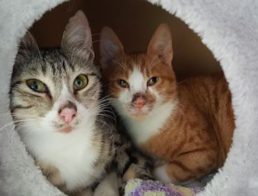Of all our pets, cats are the most likely to come down with ringworm… and possibly pass the condition on to us. Therefore, it’s vital for all cat owners to have a working understanding of the disease and how it is treated.
What is Ringworm?
Ringworm is a contagious skin disease that develops after infection with certain members of a group of fungi called “dermatophytes.” Dermatophytes can be found in almost every environment and are not just responsible for ringworm but also for other itchy diseases like jock itch and athlete’s foot.
How Can I Tell It’s Ringworm?

The big however: All of these signs can also be seen with other common skin conditions in cats. For this reason, it is simply not possible to definitively diagnose a cat with ringworm without a veterinary visit. That said, if any of the following apply, the likelihood of ringworm increases:
- A new cat or other pet has recently been added to the home.
- The affected cat is very young, very old, or has a weak immune system.
- More than one animal in the household is affected.
- People in the household have skin lesions or have been diagnosed with ringworm.
Diagnosing Ringworm in Cats
Veterinarians use several different tools to diagnose ringworm in cats. They may shine a black light over the cat’s coat looking for fluorescence. Some types of ringworm glow under the black light but others do not. This test is often used to identify areas on the body that should undergo further evaluation; it cannot say a cat is free of ringworm.
The most common ringworm test is a fungal culture. The veterinarian will pluck hairs from around skin lesions or comb the coat with a toothbrush and then “plant” the samples in a container containing a gel that selectively supports the growth of fungi. If a fungal colony develops, the veterinarian can either look at it under the microscope or send it off to a laboratory for identification. It can take several weeks for the results of a fungal culture to be finalized. In some cases, a skin biopsy may be necessary to definitively diagnose ringworm.
Your veterinarian may also recommend screening other pets in your household for ringworm. The fungus is very contagious and can be spread back and forth between individuals even if they don’t have any signs of the disease.
Treatment for Ringworm in Cats
Appropriate treatment for ringworm generally depends on the severity of a cat’s symptoms. Mild cases of ringworm will often respond to topical treatment. Options include:
- Lime sulfur dip: Most veterinarians recommend that cats get dipped in a lime sulfur solution every 3-4 days. The dip should be applied to dry skin and fur and should not be rinsed off. Be aware that lime sulfur smells bad and can stain fur and surfaces in the home.
Miconazole and chlorhexidine shampoo: Unless otherwise directed by your veterinarian, bathe your cat twice a week in chlorhexidine shampoo and/or miconazole shampoo following the instructions on the product’s label.
- Oral lufenuron: This medication is more commonly used to prevent flea infestations but may help in the treatment of ringworm when used in combination with other therapies.
- Long-haired cats can also benefit from being shaved with an electric clipper. This gives topical medications better access to the skin and physically removes fungal spores that may contaminate the environment.
For more severe cases of ringworm, veterinarians typically prescribe the oral anti-fungal medications griseofulvin or itraconazole.
Ringworm treatment generally needs to be continued for several months and should only be stopped once a cat starts to regrow normal hair or nails and repeat fungal screenings show that no ringworm is present.
Environmental decontamination is another important aspect of ringworm treatment. The fungal spores shed from an infected cat’s coat and skin pose a risk to other pets and people in the home and can even reinfect your cat once treatment is stopped.
To prevent the spread of ringworm, wash and dry potentially contaminated bedding, clothing, towels, etc. Vacuum floors, rugs, furniture, and anything else that can’t be put in the washer and dryer or thrown out. Consider having your floors, rugs, and upholstery professionally cleaned. A diluted bleach solution will kill ringworm spores on surfaces, as will accelerated hydrogen peroxide wipes and many other types of disinfectants.
Isolate any pets undergoing treatment for ringworm in an easy-to-clean room, until they have been cleared by your veterinarian. Disinfect this area twice weekly. Be sure to wear gloves, wash your hands, and change your clothes if you are cleaning or performing ringworm treatments yourself.
Finally, contact your physician if you or your family members develop skin lesions consistent with ringworm.
Featured Image Credit: Elnur, Shutterstock































